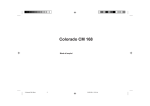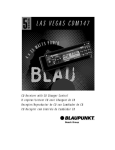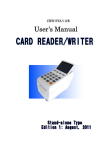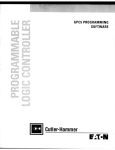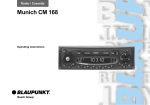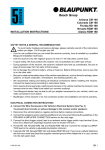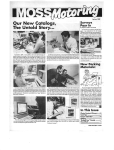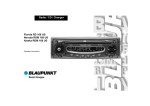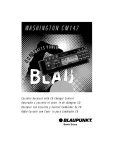Download Blaupunkt Nevada RDM 168 US Specifications
Transcript
2 Dispiay The display consists of three fields and changes according to the operating mode and function. .“‘-*%w:w\ Display field 1: Display field 2: y_. lj i \a,*” Display field 3: Radio mode Radio mode Displays active functions. Memory banks and wavebands Brief indication of preset station (e.g. Pl) Radio frequency or station name Clock display CT, Cassette mode Cassette mode CAS - cassette inserted TAPEl/TAPE2 - side of tape being played. Displays active function. Clock display lo Chanaer mode (Chanaer sold seoaratelv) Chanaer mode (Changer sold separately) Numeric and graphic representation of the volume and audio settings. CD number being played by changer. CD time (elapsed time) Brief indication of functional changes Clock display RPT - Repeat function MIX - Tracks played at random Indicates DSC mode is active. Graphic representation of the adjusted volume level. Serves as display and entry field during DSC programming Chanaer mode (Chanaer sold separately) - Stereo - Cassette inserted Disc - CD changer connected E - Loudness Radio mode - Seek tuning sensitivity Current track Miscellaneous indicates new source (e.g. when changing from radio to cassette) 3 c- Contents Display ............................................ 3 Quick reference .............................. 5 Important notes .............................. 8 What you need to know .......................... 8 Traffic safety ........................................... 8 8 Installation .............................................. . Accessories ............................................ 8 Warning note .......................................... 8 Detachable face ............................. 8 Theft protection ....................................... 8 Affixing the detachable face ................... 9 Selecting the audio source.. ......... 9 Radio operation .................................... Selecting a waveband .......................... Station tuning.. ...................................... Automatic seek tuning A / V .............. Manual tuning with <c >> .................. Switching between the memory banks (FM) ............................. Storing stations. .................................... Recalling stored stations ...................... Scanning stations with Preset Scan.. ... Scanning stations with Radio Scan.. .... Changing the scan time.. ...................... 4 IO 10 10 10 10 10 IO IO’ 11 11 11 Automatically storing the strongest stations with Travelstore.. ..... 11 Naming radio stations ........................... 11 Deleting radio station names ................ 12 Deleting a radio station name ........... 12 Deleting all of the radio station names1 2 Setting the TIMER ................................ 13 Cassette deck operation ............. 13 Cassette playback ................................ Cassette eject ....................................... Fast winding.. ........................................ Reversing the tape ............................... 13 13 13 13 CD changer operation (optional) 14 Inserting a CD.. ..................................... Switching to the CD changer mode ...... Ejecting a CD.. ...................................... CD playback ......................................... Selecting a CD.. .................................... Selecting a track ................................... SCAN .................................................... RPT ....................................................... MIX.. ...................................................... 14 14 14 14 14 14 15 15 15 CLOCK/Display changes.. ........... 15 Setting the clock ................................... 16 Turn On Message.. ....................... 16 DSC programming ....................... 16 Overview of the DSC factory settings . . 18 Appendix ....................................... 18 Specifications.. ...................................... Amplifier ............................................ Tuner ................................................. Cassette ............................................ CD changer (sold separately) ........... 18 18 18 18 18 Troubleshooting Guide ............... 19 General ................................................. Radio reception .................................... CD Changer operation.. ........................ Error Displays ....................................... 19 19 19 20 Quick reference @ REL To release the detachable face, press this knob and remove the detachable face. @ ON - Power up/down Press this button to turn the unit on. It will play at the volume set under DSC. Mute: If you press this button briefly during radio reception, the volume will turn down instantly. This function is cancelled by pressing the ON button again. You can programme the mute volume (refer to “DSC programming”). Press the button for about 1 second to turn the unit off. Switching on/off via the ignition: If the unit has been connected correspondingly, it can also be turned on and off with the vehicle ignition. If ON is pressed while no power is being supplied to the red (ignition) lead, the unit will automatically turn off after one hour. This prevents the battery from going dead. @Volume knob Turn the knob to set the volume. @ P Eject Radio mode Press this button to eject the cassette. The cassette buttons will retract. @ Cassette slot Insert the tape into the slot with the open side showing to the right. The tape will be played in the direction previously selected. @ Display Displays all settings, operating modes and functions. @ FR Fast Rewind To fast rewind the tape. AIV A . Seek tuning UP V Down cc I z-> Manual tuning << Up in short intervals >> Down in short intervals Changer mode (optional) Select CD A UP V Down Select track >> Up: press briefly CUE - fast forward (audible): hold button down. @ FF Fast Forward To fast forward the tape. @ + @) Reversing the tape (PROG) Press both buttons simultaneously. @ Rocker switch c< Down: press two or more times briefly Repeat track: press briefly. REVIEW -fast reverse (audible): hold button down. Extra function of rocker switch: The rocker is also used in these modes AUD mode 11 DSC mode 18 2 Requirement: The respective function must be activated. 5 Switching AUD off Press button briefly. If you do not change the tone within 8 sec., the AUD mode will quit automatically. @ SRC (SRC = audio source) Press button briefly to select the operating mode (tuner, cassette, changer or Aux-in). The active mode appears in the display. Setting the tone: Select the audio mode. Press AUD once and set the tone using the rocker switch. @ DSC Direct Software Control Adjusts programmable settings. Refer to “DSC programming”. Treble: A Treble + V Treble - @ (9 DIS - clock display This unit is equipped with an internal clock. Bass: c< B a s s Bass + p Display r i o r i t y Press AUD twice and set the fader and the balance using the rocker switch. A Fader front V Fader rear x-z Balance left , To alter the display priority, press (9 until you hear a beep. Repeat this procedure until the desired display appears. >> Balance right The selected values will appear in the display. The last setting is stored automatically. 6 Press this button to switch between the clock, the station name and the frequency. Cassette mode Extra function: LD Loudness boosts the bass frequency at low volume. Press AUD longer than 2 seconds to change the Loudness setting. “LD” will appear. The loudness level is set under DSC. 11 AUD 0 You can store different treble and bass settings for the FM, AM, cassette and CD changer or Aux-in modes. >> Radio mode Temporary display change Press 0 briefly as many times as needed to show the desired information for a few seconds. Press this button to switch between the track played and the clock. Chanaer mode (optional) Press this button to switch the display of the CD number, the playback time elapsed and the clock. @ Preset buttons 1 to 6 Radio mode You can store six stations in each FM memory bank (1,2, and ‘7”). On AM you can store six stations. Store station - hold down a preset button in radio mode until a beep is emitted. Recall station - select a waveband and also the memory bank on FM; press the relevant preset button briefly. The selected preset button will briefly appear in display field 1 (e.g. Pl). Changer mode (optional) @ BAITS 3/W - Pause interrupts CD play. “PAUSE” appears. Press button again to restart CD play. Switches between the wavebands/ memory banks -~FMl, FMZ, FMT ^_^\ ark ^^^I WI. AL. (Travelstore, 4lRPT Repeat track: press 4IRPT. “REPEATT” appears briefly. The track will be repeated until WRPT is pressed again. Repeat CD: select “REPEAT-D”. Switch REPEAT-D on: l Hold URPT down until a beep is emitted. Extra function: Travelstore To store the six most powerful FM or AM stations in the Travelstore bank: Select FM or AM by pressing BAITS. Press BAITS until a beep sounds and “T-STORE” appears. 5/MIX “MIX CD” plays the tracks of one CD in random order. “MIX ALL” plays the tracks of all CDs of one changer magazine in random order (as determind by the changer model). To turn MIX on/off: Press 5/MIX briefly. The current setting is briefly indicated in the display: “MIX-CD”. Switch MIX-ALL on: l Hold 5/MIX down until a beep is emitted. Changer mode (optional) F‘ress SCA. “SCAN” will be displayed. All tracks of the CD will be scanned. , @ PS - Preset Scan Press PS briefly. All currentlyreceivable stored stations will be scanned. To stop Preset Scan, press PS again. (Use DSC to set the Scantime.) @ SCA Press SCA to select the SCAN function. Use DSC programming to set the scantime. Press SCA to stop SCAN function. Radio mode Press SCA. The radio will scan all receivable FM or AM stations. “SCAN” and the station appear on the display on after another. 7 Detachable face Important notes What you need to know Before using your new car radio, please read through the following information carefully. Traffic safety As the driver of a motor vehicle, it is your responsibility to pay attention to the traffic situation at all times. Never use your car radio in a way that could distract you. Please keep in mind that you travel a distance of 15 yards per second at a speed of only 30 mph. Should the traffic situation become particularly demanding, we advise you not to use the radio. Always make sure that you are still able to hear any warning signals coming from outside the vehicle, such as police or fire engine sirens, so that you can react accordingly. Consequently, you should always select a moderate volume for playing your car radio while you are driving. instructions on installation and connection carefully. In order to ensure that the unit operates properly the positive power supply line must be connected via the ignition and the permanent +I 2 V lead. Do not ground the loudspeaker outputs! Accessories Use Blaupunkt-approved accessories and spare parts only. Changer (not included with the unit, sold separately) CDC-A08 CDGA071 CDC-A05 (with adapter only) A! Warning note Danger of damaging the automatic power antenna in a car wash Before you drive into a car wash switch the radio off by pressing the ON . button. Installation The power antenna will retract, if it doesn’t, press ON again. If you would like to install your new car radio yourself or add other audio components to Do not drive into the car wash unless the existing ones, please read the enclosed power antenna has retracted! l 8 Theft protection This unit is equipped with a detachable face. A car radio without face is worthless for thieves. Protect your car radio and detach the face when you leave your car. It is very easy to attach and detach the detachable face. Note: Do not pull the detachable face straight out from the chassis, but detach it as illustrated below. Be sure not to drop the panel. Do not expose the detachable face to direct sunlight or other heat sources. Do not leave it in a humid place. Detaching the detachable face Press the REL button to release the control panel. Then pull it off gently as illustrated. Selecting the audio source If the unit was still in operation, it will turn off now. All current settings remain stored. If a cassette is inserted, it will be kept in the unit. The radio will turn on automatically when you attach the detachable face again. Attaching the detachable face Slide the panel (6) from the left to the guide of the chassis (A). Gently push the left side of the panel against the front of the chassis until it snaps into place. Affixing the detachable face If you wish to fix the detachable face permanently to the chassis, screw down the enclosed bolt at the left hand side of the chassis into the hole (C), see Fig. Use the SRC (source) button to select between radio, cassette and CD or Aux-in mode. The CD mode is not available unless a CD changer is connected. The Aux-in mode is available if a changer is not connected. (See DSC programming.) To select the operating mode: l Press SRC. Radio operation Selecting a waveband Manual tuning with << >> With this car radio you can select between the following wavebands: You can also tune into a station manually. l Press << >z-; the frequency will change in short intervals in the downwards or upwards direction. If you hold << >> pressed to the left or the right on the rocker switch, the frequency scan will speed up. FM 87.5 - 107.9 MHz AM 530 - 1710 kHz Select the desired waveband by l pressing the BAITS button. Station tuning Switching between the memory banks (FM) Automatic seek tuning NV Press A or V; the car radio will automatically search for the next station. If you hold A/V pressed up or down on the rocker switch, seek tuning will speed up in the upwards or downwards direction. l You can switch between the memory banks FM1 , FM2 and FMT in order to store stations and recall them later. The currently selected memory bank appears in the display. l Press the BA/TS button as many times as necessary until the desired memory bank lights up in the display. Storing stations Automatic seek tuning A V 10 UP Down . On FM, you can store six stations on the preset buttons 1,2,3,4,5,6 for each of the memory banks (FMI, FM2, FMT). You can also store six stations on AM. l Select the waveband by pressing BAITS. l Tune into a station with the rocker switch (either automatically A/V or manually CC 2~). Press the desired preset button until the radio resumes play after the muting (takes approximately 2 seconds) or until you hear a beep. Now the station has been stored. l The display will temporarily indicate which preset button is currently activated. Recalling stored stations You can recall any stored station at the touch of a button. l Select the waveband by pressing BMS. For FM, also choose the corresponding memory bank by pressing the BA/TS button as many times as necessary until the desired bank appears in the display. l Press the corresponding preset button briefly to recall the station. Scanning stations with Preset Scan You can scan all of the radio stations on AM or FM. The scanned stations of the current waveband will appear briefly one after the other in the display. Start Preset Scan: Press PS briefly. “PS-Scan” and the station name or frequency will appear alternately in the display. The abbreviation for the station currently playing (e.g. Pl) will flash in display field 1 l Listen to scanned station/end Preset Scan: l Press PS briefly. Scanning stations with Radio Scan You can scan through all of the stations in your reception area. To start the Scan function: l Press SCA briefly. The scanned frequency or the station name will start flashing in the display. During the actual scanning process “SCAN” will appear in the display. Listen to scanned station/end Radio Scan: l Press SCA briefly. Changing the scan time The scan time can be selected from between 5 to a maximum of 20 seconds. If you would like to alter the scan time, please refer to the section on “DSC programming - SCANTIME”. Selecting the automatic tuning sensitivity You can alter the automatic tuning sensitivity. Automatically storing the strongest stations with Travelstore You can automatically store the six FM /AM stations with the most powerful signals in your current reception area sorted according to their signal strength. This function is particularly convenient on longer trips. Press the BAITS button to select the waveband. l Press the BMS button for 2 seconds. “T-STORE” will appear in the display. The six strongest FM stations will be automatically stored in the “FMT” memory bank (Travelstore). If “lo” is displayed, the radio will only pick up strong, local stations (low sensitivity). If the AM band is active, the six strongest AM stations will be automatically stored in the AM memory bank. If “lo” does not light up, the radio will also pick up weaker, more distant stations (high sensitivity). When this process has been completed, the radio will play the strongest station. If you would like to alter the sensitivity level please refer to the section on “DSC programming - SENS”. If desired, stations can also be stored manually in the Travelstore bank (see “Storing stations”). Naming radio stations To enable you to pick out your favorite radio station more quickly, DSC programming allows you to give up to 30 radio stations individual names. 11 The radio station does not have to be stored in the memory bank. The names are linked to the radio frequencies. Proceed as follows: Select the DSC mode. l Press DSC. l l l l l l l Deleting a radio station name Press c-z >> to switch to the stationselect mode. Select the DSC mode. Press DSC. Press A Iv to select the station you would like to name. Press <c >> to confirm your selection. Now you are in the edit mode. If the station selected does not have a name, 8 dashes I‘_” will appear in the display. The cursor will flash at the current position. Press <c >> to move the cursor. Press A / v to select a character. If you want to enter a blank, select the dash Press DSC to store the name. Press DSC again to quit the DSC mode or ’ press << >> to re-enter the stationselect mode. If you want to change the name, select the name in the DSC mode and overwrite it in the edit mode. 12 Deleting radio station names Press A I v to select STA-NAME. II ,, _. l If you want to change just a few of the letters, Deleting all of the radio station names press << >> to move the cursor to the Select the DSC mode corresponding position and change only that _ Press DSC. character. . Press A / v to select STA-NAME. . Press <c z=> to enter the station select mode. . Press and hold down DSC for 8 seconds. . After 2 seconds and 8 seconds you will hear a beep. “ONE NAME” will appear first in the display, followed by “ALLNAMES” Press A / v to select STA-NAME. Press <c >> to enter the station select mode. Press A /v to select the name you want to delete. Press and hold down DSC. “ONE NAME” will appear in the display. Release the DSC button after 2 seconds but before 8 seconds. “DELETED” will appear in the display. The station name has been deleted. The unit will switch back to DSC mode. l Release DSC. “DELETED” will appear in the display. All of the station names have been deleted. The unit will switch back to DSC mode. Cassette deck operationSetting the TIMER Cassette playback Reversing the tape Using this unit it is possible to conveniently switch on any two radio stations you select at any time you select. The radio stations can be selected independently of the currently active operating mode. Insert the tape into the slot with the open side showing to the right. The cassette playback will start. If a tape is already inserted, press SRC to select the tape deck mode. “TAPEl” or “TAPE2 will appear. The tape will be played in the direction previously selected. To change the tape direction during cassette playback: Proceed as follows: Select the radio station of your choice. Press FR/FF simultaneously. Tke display shows “TAPEl”,or “TAPE2” for the selected tape side. l Press DSC. Press h/v to select TIMER 1. Cassette eject Press >> to turn the TIMER on. (Press << to turn the TIMER off.). Press P to eject the cassette. The cassette buttons will automatically retract. Press >> again to select time display. The minutes will flash. Fast winding Press A / v to set the minutes. Press << to activate the hours. Press A / v to set the hours. Press DSC to store your entry. You have now set TIMER 1. If you would like to set TIMER 2 as well, repeat the steps as described above. Note The timers can be turned on and off while any audio source is in use. Press the FF or FR button to fast forward or rewind the tape during cassette operation: “FORWARD” or “REWIND” will light up in the display. When the end of the tape is reached with fast forward, the tape direction will change and the other side of the tape will played. With “Radio Monitor ON” during fast winding you can listen to the radio program you selected previously. It is possible to change the Radio Monitor on/off setting in the DSC mode. (Refer to “DSC programming - RM”.) 13 CD changer operation (optional) This unit offers you the ability to conveniently control a Blaupunkt CDC-A08 or CDC-A071 changer (or CDC-A05 with a special adapter), all sold separately. If a CD changer is connected, the c%% symbol will light up in the display. The changer is equipped with a magazine for 10 discs. Switching to the CD changer mode Make sure that at least one CD has been inserted into the magazine. Press SRC to change the audio source: Press SRC repeatedly until the CD functions appear in the display. l h I v CD selection A UP V Down The CD number being played will appear in the display. Ejecting a CD Inserting a CD Insert one or several CDs into the magazine (printed surface facing up). Slide the magazine into the CD changer in the direction of the arrow. The CDs are counted from bottom to top. Open the door of the CD changer and press the eject button. Selecting a track CD playback Press SIX to select the CD changer. Press SRC repeatedly until “CHANGER” appears in the display. CD playback starts with the first CD identified by the changer. l Note: Use only perfectly circular CDs with a diameter of 12 cm! CDs with a diameter of 8 cm or CDs manufactured in the shape of a mug, for example, are not suitable for use with this equipment. Using such CDs can very likely result in the destruction of the CD and the CD drive. t We assume no responsibility for damages caused by using unsuitable CDs. After you have inserted the magazine, keep the door of the magazine closed to prevent contamination. 14 Selecting a CD When CD playback starts, all active CD functions and the CD number will light up in the display. To change the display between CD number and elapsed time, press 0 during CD playback. >> Up: Press briefly. CUE - fast advance (audible): Hold button down. << Down: Press two or more times briefly. To re-start a track: Press briefly. (When at start of first track, unit goes to last track on same disc.) REVIEW - fast reverse (audible): Hold button down. Press the button repeatedly to skip several tracks. The number of the selected track will appear beside “T” (track). CLOCK/Display changes SCAN Use this function to scan all of the CD tracks. Switch REPEAT-T on: Press WRPT briefly. This unit is equipped with an internal clock. l Disolay priority To start the Scan function: l Hold down SCA until “SCAN” appears. All of the CD tracks will be scanned one after the other in ascending order. Switch REPEAT-D on: l Hold 4/RPT down until a beep is emitted. To stop the Scan function: l Press SCA briefly. The track currently scanned will continue to play. The SCAN function will also be cancelled by pressing any other button, except for the volume controls and the AUD and ON buttons. MIX Temporary display chanae You can have the CD tracks played in random order. Press ’ briefly as many times as needed to show the desired information for a few seconds. RPT CD tracks can be played repeatedly. The following options are possible: - Repeat the current track (“REPEAT-T”) or - Repeat the CD, i.e. all tracks of the current disc (“REPEAT-D”). “RPT” will appear in display field 3 as long as RPT is active. “REPEAT-T” lights up briefly in display field 2 when you activate this function and each time the track changes. The following options are possible: - Mix all tracks of one CD (“MIX-CD”) or - Mix all tracks of all CDs (“MIX-ALL”) in manner determined by the CD changer model. “MIX” will appear in display field 3 as long as the MIX function is active. “MIX-CD” lights up briefly in display field 2 when you activate this function and each time the track changes. Switch MIX-CD on: l Press 5/MIX briefly. until To alter the display priority, press you hear a beep. Repeat this procedure until the desired display appears. Radio mode Press to switch between the clock, the station name and the frequency. Cassette mode Press 1 to switch between the track played and the clock. Changer mode (optional) P r e s s to switch the display of the CD number, the playback time elapsed and the clock. Switch MIX-ALL on: Hold 5/MIX down until a beep is emitted. l 15 Setting the clock Set the clock in the DSC mode. Press DSC briefly. l Press A I v to select the function “CLOCKSEP. l l Press -z-z >> to activate the hours or the minutes. The option you can set will flash. l l l Press A/V to alter the flashing display. When you have completed the setting, press DSC briefly to store it. Turn On Message DSC programming This unit offers you the possibility to enter a turn on message of up to 40 characters. The message will briefly appear in the display each time you turn the unit on. Proceed as follows: The car radio has been equipped with DSC (Direct Software Control) to allow you to customize certain programmable, basic settings to suit your personal needs and preferences and then store them. Select the DSC mode. _ Press DSC. . Press A / v to select TOM. . Press c< to turn the message off. . Press >> two times to select the edit The basic settings for this car radio were made at the factory. mode. . If there is no TOM programmed, dashes “_I’ will appear in the display. . The cursor will flash at the current position. Press c< / >> to move the cursor. . Press A / v to select a character. If you want to enter a blank, select the dash Press DSC again to exit DSC mode. I, I, _. . Press DSC to store the message. Press DSC again to quit the DSC mode. In the following you can find an overview of these settings, so that you can always reset to them if desired. If you wish to alter any of the programming, press DSC. MENU v / A will temporarily appear in the display. l Use the A I v buttons of the rocker switch to select the function you wish to change. The display will show you the setting you have selected. Press the << z=> buttons of the rocker switch to change the settings and exit the current mode. Confirm the setting you have selected by pressing the DSC button. If you want to change the message, select L 16 TOM in the DSC mode and overwrite it in the edit mode. If you want to change just a few of the letters, press cc I >> to move the cursor to the corresponding position and change that character only. A / V Select function C-Z >> Adpst/recall setting LOUDNESS Loudness boosts the bass frequencies at low volume. LOUD 1 - Low boost LOUD 6 - Max. boost TIMER 2 You can also program the unit to go to a second station at a programmed time. SENS LO ON VOL To set the turn-on volume. Press <c >> to adjust the turn-on volume as desired. STA NAME CLOCK 12 To adjust the seek tuning sensitivity. “LO” stands for local reception. “DX” stands for distant reception. You can enter a message of up to 40 characters which appears in the display when you switch the unit on. MUTE To change the mute volume. BEEP To change the volume of the acknowledgement tone (beep) between 0 and 9. (0 = off) RM ON/OFF Radio Monitor If the Radio Monitor function is active during fast winding of the tape, the unit will switch to the radio and play the station previously CLOCKSET To set the clock. Press << >> to select hours/ minutes. Press v / h to adjust the flashing value. TIMER 1 The radio will automatically switch to a station you have selected at the time you program. Use this function to set the scan time for the radio or CD changer from 5 to 20 seconds. AUX Select AUX-ON if you wish to connect a portable CD or tape player instead of the CD changer. Contact your dealer for more information about the required adapter cable (7 607 897 093), which is sold separately. DISPLAY Display indications on or off with the car radio turned off. . TOM ON/OFF Turn-on message. Allows you to name up to 30 radio stations based on their frequency. To switch between 12 and 24-hour clock display. SCANTIME 17 Appendix Overview of the DSC factory settings Specifications LOUDNESS SENS CLOCKTYPE CLOCKSET ON VOL MUTE BEEP RM SCANTIME AUX DIS Power output and total harmonic distortion: 3 DX CLOCK 12 20 IO 3 OFF 10 sec. OFF ON Amplifier 17 watts per channel minimum continuous average output into 4 ohms. 4 channels driven from 30-I 5000 Hz with no more than 1% total harmonic distortion. 4 x 40 Watts max. power. Tuner Wavebands: : FM : AM 87.5 - 107.9 MHz 530 - 1710 kHz FM frequency response: 35-16000Hz Cassette Frequency response: 35-16000Hz CD changer (sold separately) CDC-A071 CDC-A08 CDC-A05 (with special adapter cable) Frequency response: 20 - 20000 Hz 18 Features and specifications subject to change without notice. Troubleshooting Guide The following check will assist in the correction of most problems which you may encounter with your unit. Before going through the check list below, refer back to the connection and operating procedures. General Trouble Cause/Solution No sound. l l 3 Adjust the volume with the volume knob. With a two-speaker system, set the fader control to the center position. Radio reception Trouble Cause/Solution Preset stations are not receivable. l The broadcast is too weak. Automatic tuning is not possible. l The broadcast is too weak - Use manual tuning. l Not enough broadcast frequencies are receivable. Travelstore feature does not complete storing of six stations. Also make sure that antenna is connected, extended and dry inside. CD Changer operation Trouble Cause/Solution CD does not start. l The disk cannot be loaded or is automatically ejected. The sound skips due to vibration. l Dusty or defective disc. The ambient temperature is more then 50” C (120” F). l The disc is inserted with the printed side downwards. l l l The changer is installed at an angle of more than 20”. The changer is not installed on the sturdy part of a car. Dusty or defective disc. 19 Error Displays Trouble Cause Solution “CD ERR” A disc such as an upside down or dirty disk, or a CD-ROM (computer) disc. Insert the disc correctly. Clean the disc. “NO DISC” No magazine or disc in changer Take out the magazine and insert the disc. If the above mentioned solutions do not help to improve the situation, consult your nearest Blaupunkt dealer or in the United States call l-800-266-2528. 20 Bosch Group Blaupunkt-Werke GmbH Postfach777777 D-31 132 Hildesheim Germany Robert Bosch Corporation Sales Group - Blaupunkt Division 2800 South 25th Avenue, Broadview, Illinois 80153 1-800-950-BLAU Made in Malaysia Fabrique en Malasie Hecho en Mlasia Fabricado en Mlaysia Copyright 1998 by the Robert Bosch Corporation No portion of this work may be reproduced in any form without the written consent of the Robert Bosch Corporation. BPNKD-Nr. 8 822 401 534 - ~ -- _ Bosch Group Arizona CM 148 Colorado CM 168 Florida RD 168 Nevada RDM 168 Alaska RDM 168 INSTALLATION INSTRUCTIONS . SAFTEY NOTES & GENERAL RECOMMENDATIONS To avoid costly mistakes and serious damage, please carefully read all of the instructions I. before you begin. You’ll be glad you did! . If you’re not confident that you can install the receiver correctly, have it installed by a qualified Blaupunkt installation technician. . Use this receiver only with negative ground 12-Volt (1 l-l 6 Volt) direct current (DC). . A quick-acting 10A fuse protects this receiver. Do not substitute any other type of fuse. . During operation of the receiver, the receiver’s sidewall may heat up considerably. Be sure to keep all wires away from hot parts of the housing. . Do not damage the vehicle’s battery, wiring or fuse box. Before drilling holes, look to see what is on the other side! . Be sure to observe the safety notes of the vehicle manufacturer, such as those for airbags, alarm systems, on-board computers, immobilisers, and braking systems, etc. . We recommend making and testing all electrical connections before installing the receiver. Connect the leads (wires) according to instructions below. . Don’t assume that a seemingly-matching wire harness in the vehicle matches the receiver’s wire harness wire-for-wire. Make sure before you connect anything! . Your Blaupunkt dealer may be able to sell you adapter harnesses for your vehicle, which can make connections much easier. . Modification of this receiver or its mis-connection and/or mis-installation will void its warranty. A ELECTRICAL CONNECTION INSTRUCTIONS A. Connect the Wire Harnesses to the Vehicle’s Electrical System (See Fig. 4) To prevent short circuits or serious damage to the receiver and/or speakers: 1. Disconnect the vehicle battery’s negative terminal before making connections. 2. Connect the speakers and/or external amplifiers (if you have any) following the guidelines in the SPEAKER & AMPLIFIER CONNECTION section on the next page. 3. Connect the blue (trigger output) lead to an antenna motor trigger switch input terminal (if you have one). (Maximum amperage required must not exceed 150 mA.) 4. Florida RD 168, Nevada RDM 168, and Alaska RDM 168 only: Connect the orange ILLUMINATION lead to the vehicle’s adjustable illumination (dimmer). 5. Colorado CM 168, Nevada RDM 168, and Alaska RDM 168 only: If you have a cellular telephone set that has a mute lead (lead that supplies constant ground when telephone is in use), connect it to the dark green lead. 8622401550 GB 1 6. Connect the black (power ground) lead to a grounded metal part on the vehicle. We recommend grounding all audio system black ground leads (receiver, changer,-additional amplifiers, etc.) to a common grounding point, preferably a non-painted surface under the instrument panel. Fig. 4 7. Connect the yellow (constant power) input lead to a source of constant battery power, preferably directly to the battery. The wire must be 18-gauge or thicker. 8. After the other leads are connected, connect the red turn-on “IGNITION” lead using either of the following alternatives: A. (Recommended) - Connect it to a positive (+) 12 Volt power terminal that is energized only when the ignition key is set to the “on” position or accessory position. (You can still turn the unit on for one hour even if the ignition is off.) B. This lead can instead be connected to a source of constant power, however, your receiver’s operation will be completely separate from the ignition. With either alternative, the receiver’s DSC Setting “DISP ON/OFF” allows you to choose whether or not the receiver and its display are illuminated when the receiver is turned off, but still receiving power via the red lead. 9. Cover the ends of any unused leads with electrical tape. This will prevent them from touching the vehicle or each other and causing a short circuit and damage to the receiver or vehicle. 1 O.Reconnect the vehicle’s battery. 11 .Verify that no fuses have blown. . B. Test the Connections 1. To help prevent possible electrical damage from accidental misconnection of the receiver, first attach your vehicle’s antenna. (With Florida RD 168, Nevada RDM 168 and Alaska RDM 168 only: if necessary, attach the antenna “elbow” connector and affixing bracket to the back of the receiver.) 2. Be sure to detach the faceplate before you start to connect the receiver. 3. Plug the harness into the receiver. 4. Verify that the receiver’s and vehicle’s fuses haven’t blown. 5. Attach the faceplate and test the receiver. 6. Once the connections have been successfully made, you can begin the INSTALLATION. (See below.) GB2 SPEAKER 81 AMPLIFIER CONNECTIONS The receiver’s Dual-Level Fader allows you to fade between the front and the rear channels using the receiver’s internally-amplified output via front and/or rear speaker leads AND/OR its 4-channel preamp output, providing tremendous flexibility in configuring your audio system arrangement: You can connect a speaker (regular, co-axial or tri-axial speakers or component speaker system, all hereafter referred to simply as “speaker”) to each of the receivers’ four pairs of speaker leads. With the Blaupunkt preamp output adapter 7 607 893 093 (available separately], you can provide 4-channel preamp output to additional external amplifiers and power multiple speakers or speaker systems through those amplifiers. (Blaupunkt amplifiers and speakers available separately). You can use either or both of these two methods. l l l Connecting Speakers to the Outputs from the Receiver’s Internal Amplifier To prevent short circuits or serious damage to the receiver and/or speakers: . Disconnect the vehicle battery’s negative terminal before making connections. . Connect the speaker leads only as indicated on the speaker wire block. (See Fig. 6) . Only use speakers that have impedance ratings of 4 ohms or higher and have power-handling capabilities greater than the receiver’s stated power level. . The receiver’s internal amplifier is designed to handle a 4-ohm load on each pair of speaker leads. . DON’T connect two speakers to a single pair of speaker leads (“in parallel”) unless both speakers each have at least 8 ohms impedance. . DON’T connect the left and right speaker leads to each other or to the same speakers. . DON’T connect the front and rear speaker leads to each other or to the same speakers. . DON’T connect the negative speaker leads to each other. . DON’T connect the positive speaker leads to each other. . DON’T connect any active speakers (with built-in amplifiers) to the speaker leads unless their owner’s manuals specifically state that this is O.K. . Cover the ends of any unused leads with electrical tape. This will prevent them from touching the vehicle or each other and causing a short-circuit and damage to the receiver or vehicle. . Make the other electrical connections. (See previous page.) GB3 Connecting Additional Amplifiers or an Equalizer to the Receiver’s Preamp Output Obtain the Blaupunkt RCA 4-channel preamp output adapter 7 607 893 093 from your dealer. It includes a blue/white trigger lead for switching the amplifier on and off. Connect the adapter into the top left section of the connector block on the back of the receiver. (See Fig. 7) Follow the amplifier’s or equalizer’s instructions regarding connection. (Blaupunkt amplifiers available separately). Fig. 7 . fi4’,$” CD CHANGER OR AUX-IN CONNECTION (Arizona, CM 148, Colorado CM 168, Nevada RDM 168, & Alaska RDM 168 Receivers) CD Changer Connection These receivers can control a Blaupunkt CDC-A08 or CDC-A071 CD Changer (or with the adapter harness 7 607 889 093, they can control a Blaupunkt CDC-A05 CD Changer) (Al/available separately.) The changer cable plugs into the right top connector block on the back of the receiver. (See Fig. 6) See the changer instructions for details. Fig. 6 Aux Input If a changer is not connected, you can connect portable audio equipment to your receiver by purchasing Blaupunkt accessory harness 7 607 897 093. It connects to the right top block on the rear of the receiver. It includes a 2-meter aux-in cable with a 3.5 mm male plug for direct insert into your portable equipment. WIRELESS REMOTE CONTROL (Colorado CM 168, Nevada RDM 168, & Alaska RDM 168 only) This receiver’s most-frequently used features can be conveniently controlled from the steering wheel with Blaupunkt’s unique Thummer III Steering-Wheel Remote Control. (Availableseparately.) The Thummer III includes a receiving “eye” that can be placed virtually anywhere on the dash, which connects into the center top block on the back of the receiver. GB4 INSTALLATION INSTUCTIONS Recommendations l l l l . Carefully choose the mounting location so that the receiver won’t interfere with normal driving. Avoid mounting locations where the receiver would be subject to high temperatures, such as from direct sunlight or hot air from the heater, or where it would subject to dust, dirt or excessive vibration. The illustration below shows a typical installation, however, you may need to adjust the installation, depending on the receiver. If you have questions or need additional installation hardware, consult your Blaupunkt dealer. Make sure the receiver is firmly anchored (preferably at both front and back) and does not vibrate. Installing the Receiver in Most Dashboards This car receiver and its mounting bracket are designed for installation in vehicles with a standard DIN installation compartment measuring 182 x 53 mm, a 165 mm installation depth and an instrument panel thickness of approximately 1 to 20 mm in. the area of the tab fasteners. (See Fig. 1) 1. Place the mounting bracket in the compartment and bend over all of the tabs possible. (See Fig. 2) 2. Your vehicle may also allow you to provide extra stability at the back of the receiver. Look at the wall behind the radio cavity to see if there is a small hole the size of the enclosed plastic plug, If so, screw it onto the treaded bold at the back of the receiver before pushing it into the mounting bracket. 3. With the detachable face off, place the receiver into the mounting bracket and push it in until the side springs snap into position on the left and right. (You will hear an audible click.) 4. To remove the receiver, see the maintenance section on the next page. Fig. 1 Fig. 2 GB5 Installing the Receiver in a Japanese Car This receiver is designed for easy installation in most popular Japanese cars that have “ISO” (sidebracket) mounting system. If you have questions, ask your Blaupunkt dealer. 1. Remove the vehicle’s “bezel” trim piece and the remove the existing radio. 2. Unscrew the bolts on each side of the receiver to remove the trim ring. Save the trim ring in case you ever want to install the receiver in another vehicle. 3. Use the vehicle’s own mounting hardware to attach the unit. 4. With the detachable face removed, reinstall the vehicle’s bezel. 5. Only after the bezel in reinstalled, attach the face. max. M5x8 NISSAN TOYOTA max. &M5x8 max. max. M5x8 M5x8 MAINTENANCE Removing the Receiver Insert the “release handles” into the holes in the panel on the left and right of the receiver and push them in until you hear a distinct snap, which indicates the side springs are unlocked. Pull the unit out using both handles. (See Fig. 3) Note: Handles that have snapped into place can only be removed after you have pulled the receiver out of the complement. Remember where you store the “release handles”. Fig. 3 Fuse Replacement When replacing the fuse, be sure to use one with the correct amperage, which will be stated on the fuse case. Never use a fuse that has a stated amperage exceeding the one supplied for this receiver as this could cause malfunction and serious damage to the receiver. GB6 Cleaning the Connectors The receiver may not operate properly if the connectors between the receiver and the detachable face are contaminated with dirt. To clean the connectors, use a cotton swab and isopropyl alcohol (90% or higher). Be sure to clean them with a vertical motion. Never clean them horizontally, because this could damage the contact points. Affixing the Detachable Face for Retail Display The detachable face can be affixed to the receiver’s chassis, which is desirable for a retail display. To affix the face, obtain the small self-tapping screw from the hardware pack and drive it into the upper hole at the front left side of the chassis using a Phillips screwdriver. The bolt will self-thread the hole. (See Fig. 8) Fig. 8 Faceplate affixing screw goes here . TROUBLESHOOTING - Refer to the receiver’s Owner’s Manual. If you have questions, please consult your Blaupunkt dealer or in the United States call l-800-266-2528. Installer - These Installation Instructions are the property of the consumer! Make sure they are left in the vehicle! 8622401550 GB7





























